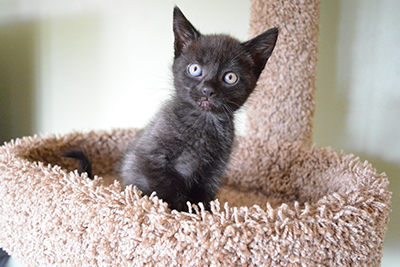
AJ Debiasse, a technician in Stroudsburg, PA, contributed to this article.
Feline cryptorchidism, also called undescended testicle or retained testicle, is a condition where one or both of the testicles stay in the belly, instead of being in the scrotum or sac. Although this genetic disorder may seem unimportant, it is actually a big deal.
When a kitten is born, the testicles live in the belly, near the kidneys. As the kitten ages, the testicles slowly migrate to their normal location, which is the scrotum. They should arrive there by 2 months of age, and not 6 months, as many believe. Making sure the testicles are where they belong should be part of your kitten’s first veterinary visit. It’s another reason why this first visit is so important.
If one testicle is undescended, the condition is called “unilateral cryptorchidism.” When both testicles are affected, the cat has “bilateral cryptorchidism.”
Where do the testicles go?
Another way to describe cryptorchidism is by location. There are 2 main locations for the undescended testicle(s) to end up:
- In the belly (abdominal cryptorchidism)
- Where the abdomen meets the back leg (called the inguinal region [inguinal cryptorchidism])
Depending upon the location, your vet may be able to locate the undescended testicle during a physical exam.
Diagnosing cryptorchidism in cats
Sometimes, it can be tricky to diagnose a newly adopted kitty with cryptorchidism. How can you tell if there are no testicles in the scrotum because they got lazy and stayed in the belly, or if the cat has been neutered? Intact or non-neutered cats have a strange feature that reveals the answer: once they reach sexual maturity, at around 9 months, their penis becomes covered with spikes, called barbs. Once a cat is neutered, the barbs disappear. So there is typically no need to test the level of testosterone in cats. The diagnosis of bilateral cryptorchidism can be based on the presence of barbs on the penis after 9 months of age.
What problems are caused by cryptorchidism in cats?
Leaving a cryptorchid cat intact (i.e. not neutered) can cause two serious health problems:
- The first one is testicular cancer. Even though the probability of spreading (metastasis) is low, it is still possible. Therefore, leaving your pet intact can be an unnecessary risk.
- The second risk is “testicular torsion,” which is less common. A testicle retained in the belly is free-floating, instead of being in a fixed position in the scrotum, and it could twist on itself. This is a very painful condition, which can be tricky to diagnose.
Treating cryptorchidism in cats
Regardless of your cat’s age, when the disorder is diagnosed and whether it is unilateral or bilateral, it is always recommended that you have it corrected. The only treatment is to have your cat neutered (i.e. have both testicles removed).
Neutering a cryptorchid cat is a bit more involved than a regular neuter, since your vet will need to find the missing testicle(s), inside the belly or in the inguinal area.
Preventing cryptorchidism in cats
Since cryptorchidism is a genetic disease, it is not recommended to breed cats with the unilateral condition (i.e. one testicle only), as they will pass it along. However, most cats with bilateral cryptorchidism are sterile. The reason for this may be that the temperature inside the body is too high and sperm are unable to form normally.
Questions to ask you veterinarian if your cat is cryptorchid:
- Is it unilateral or bilateral?
- Is it abdominal or inguinal?
- What is the best course of action to neuter my cat?
If you have any questions or concerns, you should always visit or call your veterinarian -- they are your best resource to ensure the health and well-being of your pets.
